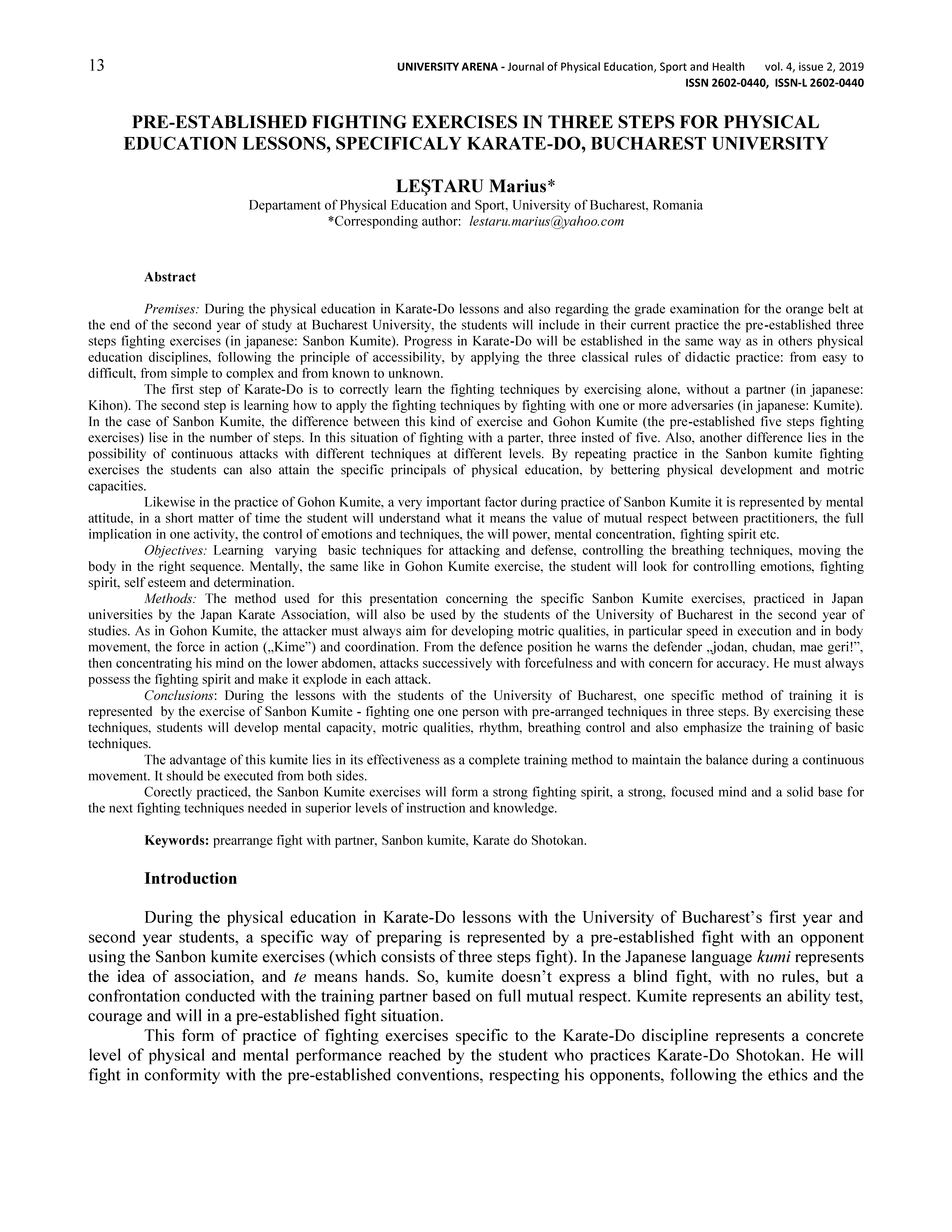PRE-ESTABLISHED FIGHTING EXERCISES IN THREE STEPS FOR PHYSICAL EDUCATION LESSONS, SPECIFICALY KARATE-DO, BUCHAREST UNIVERSITY
DOI:
https://doi.org/10.62229/UaIV_2_19-2Keywords:
prearrange fight with partner, Sanbon kumite, Karate do ShotokanAbstract
Premises: During the physical education in Karate-Do lessons and also regarding the grade examination for the orange belt at the end of the second year of study at Bucharest University, the students will include in their current practice the pre-established three steps fighting exercises (in japanese: Sanbon Kumite). Progress in Karate-Do will be established in the same way as in others physical education disciplines, following the principle of accessibility, by applying the three classical rules of didactic practice: from easy to difficult, from simple to complex and from known to unknown. The first step of Karate-Do is to correctly learn the fighting techniques by exercising alone, without a partner (in japanese: Kihon). The second step is learning how to apply the fighting techniques by fighting with one or more adversaries (in japanese: Kumite). In the case of Sanbon Kumite, the difference between this kind of exercise and Gohon Kumite (the pre-established five steps fighting exercises) lise in the number of steps. In this situation of fighting with a parter, three insted of five. Also, another difference lies in the possibility of continuous attacks with different techniques at different levels. By repeating practice in the Sanbon kumite fighting exercises the students can also attain the specific principals of physical education, by bettering physical development and motric capacities. Likewise in the practice of Gohon Kumite, a very important factor during practice of Sanbon Kumite it is represented by mental attitude, in a short matter of time the student will understand what it means the value of mutual respect between practitioners, the full implication in one activity, the control of emotions and techniques, the will power, mental concentration, fighting spirit etc.
Objectives: Learning varying basic techniques for attacking and defense, controlling the breathing techniques, moving the body in the right sequence. Mentally, the same like in Gohon Kumite exercise, the student will look for controlling emotions, fighting spirit, self esteem and determination.
Methods: The method used for this presentation concerning the specific Sanbon Kumite exercises, practiced in Japan universities by the Japan Karate Association, will also be used by the students of the University of Bucharest in the second year of studies. As in Gohon Kumite, the attacker must always aim for developing motric qualities, in particular speed in execution and in body movement, the force in action („Kime”) and coordination. From the defence position he warns the defender „jodan, chudan, mae geri!”, then concentrating his mind on the lower abdomen, attacks successively with forcefulness and with concern for accuracy. He must always possess the fighting spirit and make it explode in each attack.
Conclusions: During the lessons with the students of the University of Bucharest, one specific method of training it is represented by the exercise of Sanbon Kumite - fighting one one person with pre-arranged techniques in three steps. By exercising these techniques, students will develop mental capacity, motric qualities, rhythm, breathing control and also emphasize the training of basic techniques. The advantage of this kumite lies in its effectiveness as a complete training method to maintain the balance during a continuous movement. It should be executed from both sides. Corectly practiced, the Sanbon Kumite exercises will form a strong fighting spirit, a strong, focused mind and a solid base for the next fighting techniques needed in superior levels of instruction and knowledge.


